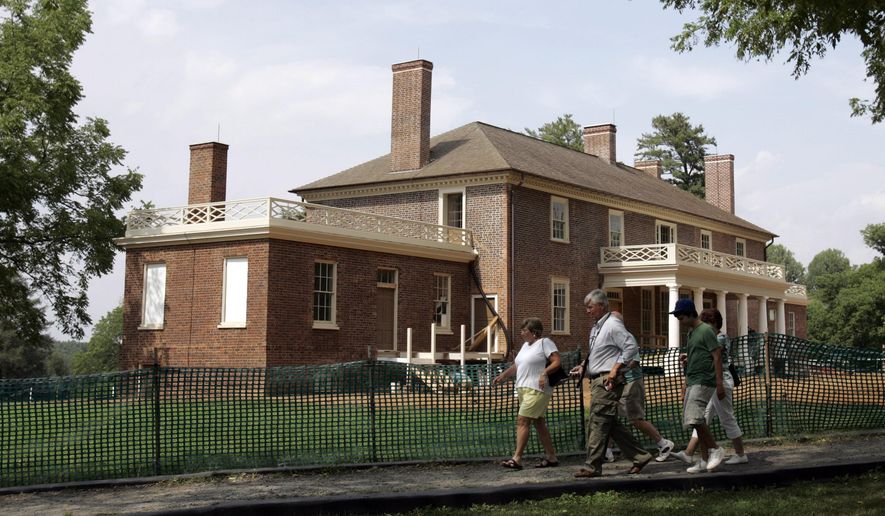OPINION:
Montpelier, the home of James Madison, has been taken over by the radical left.
In the past few months, a battle had been waging between the Montpelier Descendent Committee and the Montpelier Foundation’s board of directors. Recently, the board was expected to select nine of the 20 candidates put forward by the MDC; they gave the MDC members board majority by selecting 11. We can now expect Madison’s legacy — the fourth president of the United States and key architect of the U.S. Constitution — to be effectively erased.
The Montpelier Foundation has a goal of structural parity with descendants of former slaves, to make them “coequals in sharing governing power.” Only two of the 20 candidates indicated they have a lineage traceable to Montpelier; one of those two was elected. But all 20 were still eligible under the rules established by the misnamed “Descendent” Committee. According to Montpelier’s 2018 rubric on how slavery should be taught, a “descendent community” can include not only those whose ancestors were enslaved but also “those who feel connected to the work the institution is doing, whether or not they know of a genealogical connection.”
Previously, the MDC wanted the exclusive privilege of naming 50% of board members, which would have granted them significant power over the exhibit content at Montpelier (power they now have). The controversy started in March because the board voted that they would “allow the MDC to continue nominating board members, but not require the foundation to seat them.” The board of directors was still willing to listen to the MDC but was unwilling to rubber-stamp their candidates.
The board also wished to put forth its own candidates, candidates who are descendants but not members of the MDC specifically. Board member Mary Alexander, for example, is a descendant of Paul Jennings, James Madison’s valet, but not a member of the MDC. She has argued that the MDC should be disbanded, that they are “a Black history and Black rights organization that could care less about James Madison and his legacy.”
Her assessment seems correct. Among those nominated by the MDC was Leslie Alexander, whose research appears in the “1619 Project”; former CNN host Soledad O’Brien; Maureen Costello, executive director for the Center for Antiracist Education and former teaching tolerance director at the Southern Poverty Law Center; and Hasan Kwame Jeffries, chair of the Teaching Hard History Advisory Board of the Southern Poverty Law Center. Ms. Alexander, Ms. O’Brien and Mr. Jeffries were confirmed, and the remaining candidates will be invited to join an Advisory Council.
Qualification for the MDC seems to be far more about political ideology than genealogy. The SPLC is famous for maintaining a list of “hate groups,” which has come to include right-of-center organizations, such as the Alliance Defending Freedom. As Peter Wood writes in “1620: A Critical Response to the 1619 Project,” the SPLC has “a long-standing commitment to pushing a radical racial history curriculum in the schools.”
The March dispute led to the firing of some longtime Montpelier employees for “repeated and disruptive violations of our employment policies,” according to Board Chair Gene Hickok. The National Trust for Historic Preservation, which owns Montpelier, sided with the MDC, and questioned: “whether a resolution [was] possible under the current leadership of the Foundation.” Both Gene Hickock and Foundation CEO and President Roy F. Young have stepped down. James French, the leader of the MDC, has been named Montpelier’s new board chair.
Many have been caricaturing the disagreement between the Montpelier Foundation and MDC, contending that Montpelier does not want to discuss slavery at all. Director of Archeology Matt Reeves, one of the employees who was fired, remarked that the board was “looking to cleanse Montpelier of anything that goes beyond their message, or any narrative that critiques Madison. It is unfortunate. It is taking Montpelier back in time.”
This is disingenuous, as there are currently no exhibits at Montpelier on James Madison himself. Madison’s accomplishments are only discussed in a video at the visitor’s center and during a portion of the house tour. The Mere Distinction of Colour exhibit, which includes several exhibits on slavery in the cellars and the south yard, is extensive. The story of slavery is not only being told at Montpelier: It already is the dominant narrative.
Some of the exhibits go beyond giving a historic account of slavery. In one of the cellars is an 11-minute video developed by Mr. Jeffries and others on slavery’s “lasting legacies.” On its website, Montpelier notes, “From mass incarceration, to the achievement gap, to housing discrimination, and the vicious cycle of poverty, violence, and lack of opportunity throughout America’s inner cities, the legacies of 200 years of African American bondage are still with us.”
According to the Montpelier rubric, “[f]or institutions that interpret slavery, it is not enough simply to discuss the humanity and contributions of the enslaved. It is imperative that these institutions also unpack and interrogate white privilege and supremacy and systemic racism.”
When touring Montpelier, visitors learn little about James Madison: the political philosopher, statesman and Founding Father. There are no exhibits dedicated to his essential role in drafting the Constitution and the Bill of Rights, his authorship of much of The Federalist Papers, or his seminal defense of religious freedom.
With the MDC winning this disagreement, it looks as if the American people will lose an epicenter of our nation’s history.
• Brenda M. Hafera is the assistant director and senior policy analyst at the Simon Center for American Studies at the Heritage Foundation.




Please read our comment policy before commenting.